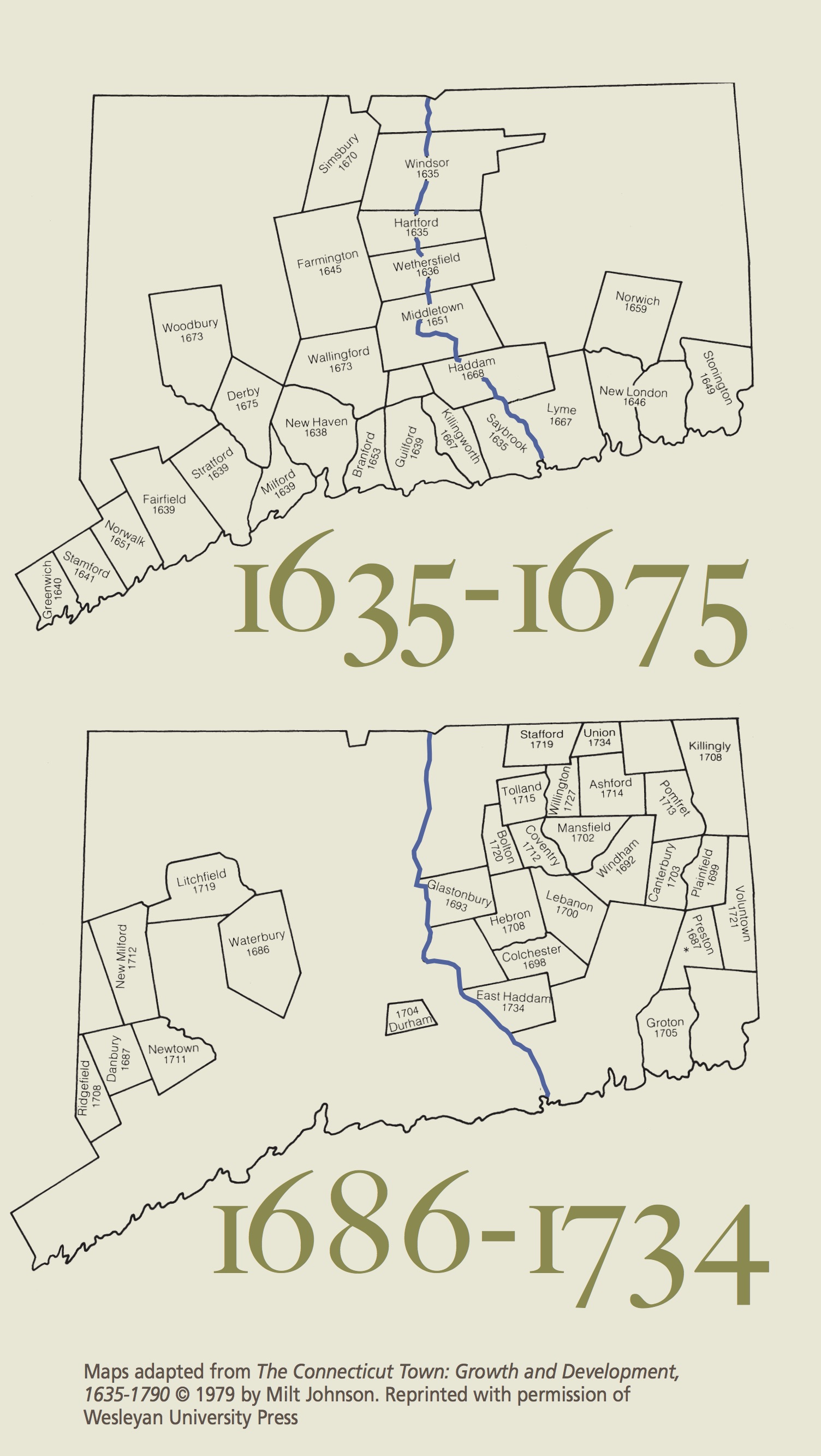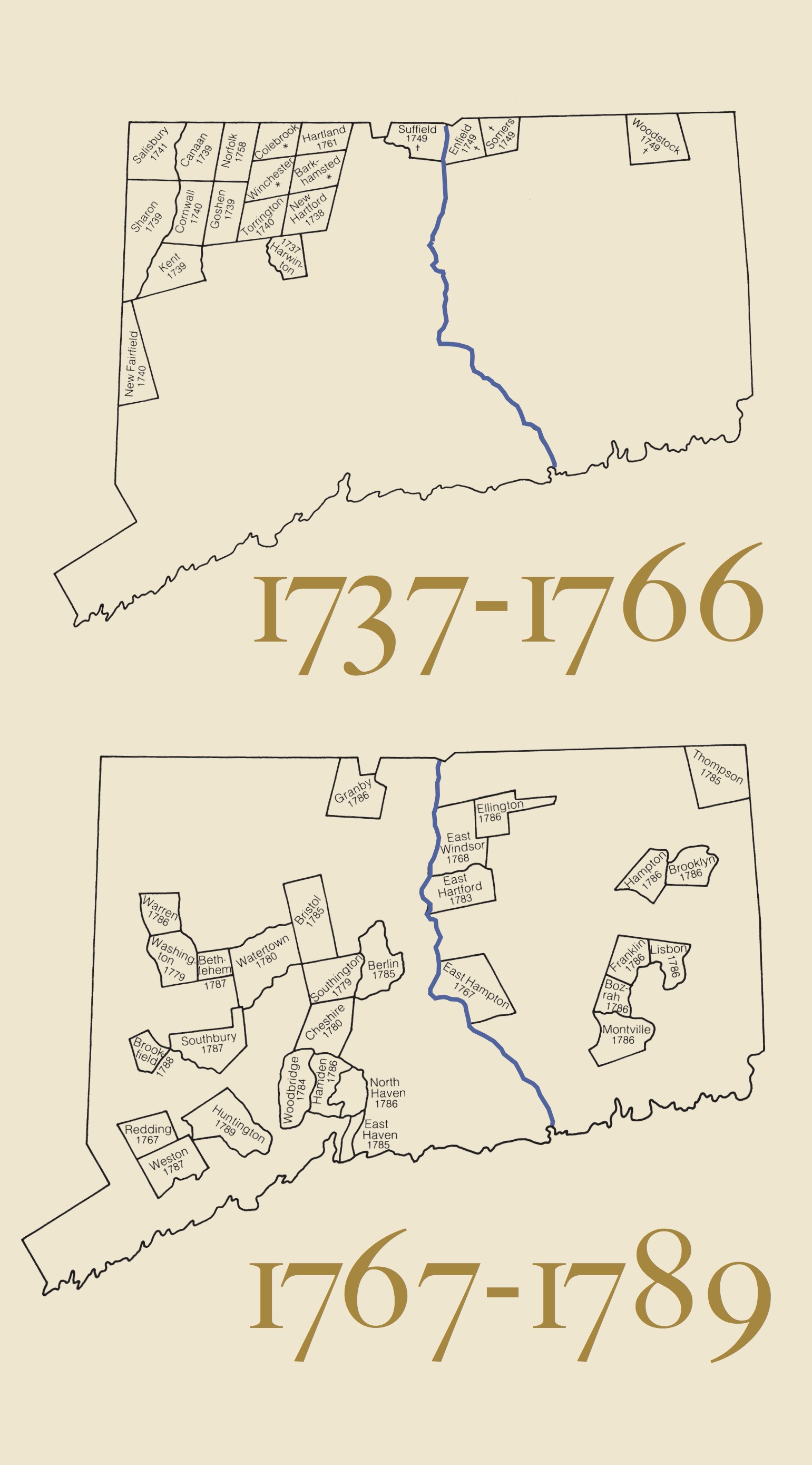The Connecticut River
January 29, 2017The Pequot War
January 30, 2017
Settling Connecticut
Connecticut’s 169 towns didn’t happen all at once. It took more than 250 years for all of Connecticut’s towns to be established!
1635 – 1675
The Pilgrims arrived in the “new world” in 1620. Just 15 years later, settlers began leaving the Massachusetts Bay Colony for a fresh start in Connecticut. During the next 40 years, 25 towns were settled. (Map 1)
The first towns formed inland on the Connecticut River. Towns also quickly settled along Long Island Sound from Greenwich to Stonington.
Each of the first towns was settled near a body of water. Waterways provided food to eat. They made travel and trading easier. Land near rivers was fertile and was a good place to farm. The early towns formed where they did because of good farmland and good trading.
The first towns formed for religious reasons, too. The settlers were Congregationalists who wanted to worship in their own way.
The meetinghouse was one of the first buildings erected in a new town. The meetinghouse was used for town meetings and for worship. In colonial Connecticut, everyone had to attend church. Congregationalists didn’t celebrate the Christian holidays of Christmas or Easter! People paid taxes to support the minister. This began to change after 1700.
The three river towns of Windsor, Wethersfield, and Hartford banded together to form the Connecticut Colony in 1636. Towns surrounding New Haven formed the New Haven Colony in 1638. The two colonies merged in 1665.

1686 – 1734
King Philip’s War kept people from settling new towns for several years. King Philip was the British name for Wampanoag sachem Metacom. Native American tribes under Metacom tried to drive the settlers out of New England. The Connecticut Colony sent soldiers to fight. Most of the fighting was in Rhode Island and Massachusetts. But Simsbury was burned to the ground.
After the war, 28 towns formed between 1686 and 1734. (Map 2) Something new was happening. Not all towns were new settlements. Five towns split off from existing towns. This happened when the population grew large enough to support its own meetinghouse. East Haddam is a good example. It separated from Haddam in 1734. Look at the map to see why that town might have split from Haddam.
Most of these new towns formed east of the Connecticut River. They formed along smaller rivers and streams. The land was less fertile there, but the streams provided waterpower for mills. These towns formed for economic reasons.
1737 – 1766
By 1737, Connecticut was almost entirely settled. Fourteen towns in the northwest corner formed in a new way. This large area of land was owned by people in Hartford and Windsor. The landowners planned seven new towns. They sold the lots to settlers or groups of settlers. It was a business venture. The Connecticut General Assembly supervised the creation of seven more towns.
In addition, four towns were annexed from Massachusetts. Suffield, Enfield, Somers, and Woodstock joined Connecticut in 1749. Connecticut’s shape and borders were now close to what they are today.

1767 – 1921
During the era of the American Revolution, 29 new towns formed. Connecticut became a state in 1788. The new towns split off from towns that already existed. (Map 4) Thompson was one of these towns. Compare the four maps to see which towns split from earlier settlements.
After 1789, more than 50 towns formed by separating from other towns.
 Today, Connecticut has 169 towns. Towns are grouped into larger sections of the state called counties. Of our eight counties, four formed in 1666. They are New London County, New Haven County, Hartford County, and Fairfield County. The other four counties were added by 1785. These counties are Tolland County, Windham County, Middlesex County, and Litchfield County. Connecticut abolished county government in 1960. Today counties are geographical groupings but have no government role.
Today, Connecticut has 169 towns. Towns are grouped into larger sections of the state called counties. Of our eight counties, four formed in 1666. They are New London County, New Haven County, Hartford County, and Fairfield County. The other four counties were added by 1785. These counties are Tolland County, Windham County, Middlesex County, and Litchfield County. Connecticut abolished county government in 1960. Today counties are geographical groupings but have no government role.
Find a complete list of towns in the order they were founded on the Secretary of State’s website HERE.
This essay is adapted from “Connecticut’s Brand of Colonial Town,” Connecticut Explored, Summer 2016 and Bruce Daniels, The Connecticut Town: Growth and Development 1635 – 1790 (Wesleyan University Press, 1979).
Glossary
Annex to attach as an addition
Congregationalist a member of the Congregational Church, which is a church governed by its members
Establish to put securely in place
Population the number of people living in a place
Sachem the name used by Algonquian tribes for chief or leader




 Today, Connecticut has 169 towns. Towns are grouped into larger sections of the state called counties. Of our eight counties, four formed in 1666. They are New London County, New Haven County, Hartford County, and Fairfield County. The other four counties were added by 1785. These counties are Tolland County, Windham County, Middlesex County, and Litchfield County. Connecticut abolished county government in 1960. Today counties are geographical groupings but have no government role.
Today, Connecticut has 169 towns. Towns are grouped into larger sections of the state called counties. Of our eight counties, four formed in 1666. They are New London County, New Haven County, Hartford County, and Fairfield County. The other four counties were added by 1785. These counties are Tolland County, Windham County, Middlesex County, and Litchfield County. Connecticut abolished county government in 1960. Today counties are geographical groupings but have no government role.